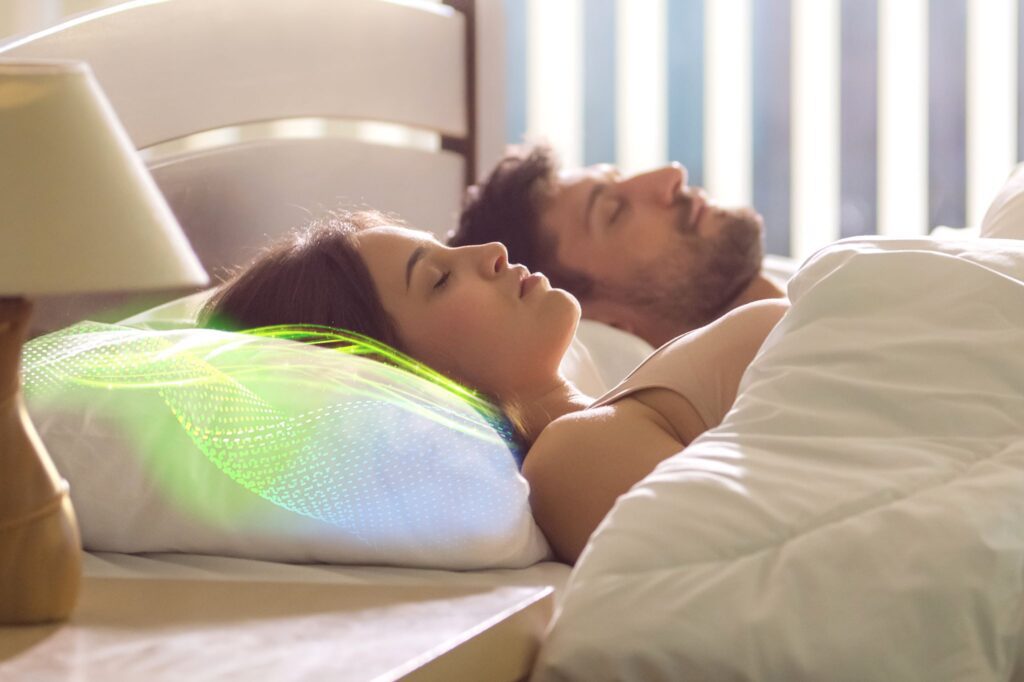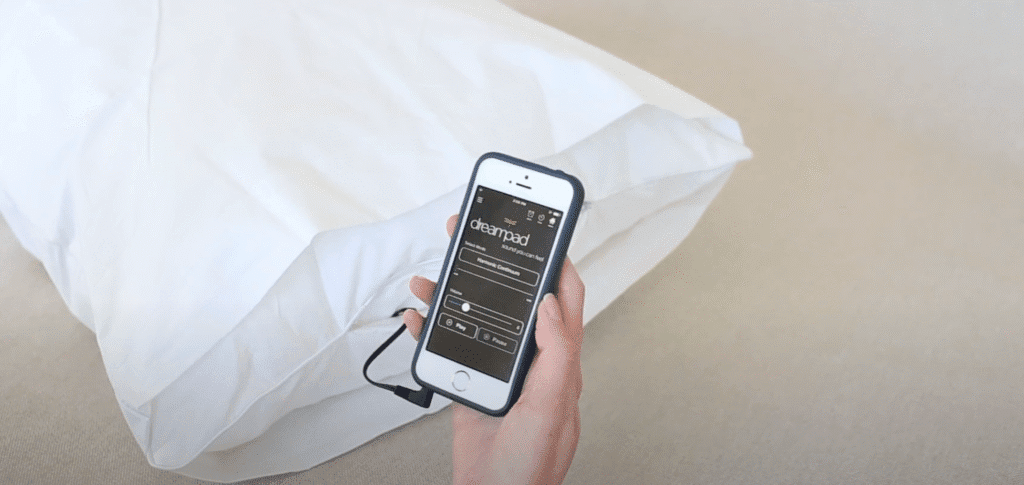Dreampad Music Pillow Review: Sound-Tech You Need to Try for Restful Nights
Looking for a smarter way to wind down at night? The Dreampad Music Pillow blends sound therapy with subtle vibration technology to help quiet your mind and ease you into a deeper sleep—without disturbing your partner.
Unlike traditional audio devices, the Dreampad delivers music through gentle vibrations that only you can hear, creating a calming experience that feels surprisingly personal.
In this review, we’ll cover how it works, how it compares to SleepPhones and other alternatives, and why it’s become a go-to for both adults and kids needing better sleep.
If you’re curious to try it, you can get 15% off with code sleepessentials15 or shop with the discount here.

Disclosure: This article contains affiliate links.
What is the Dreampad Pillow?
The Dreampad goes beyond a typical sleep aid pillow—it’s a non-audio sleep solution designed to support more consistent rest.
By transmitting gentle audio directly to the inner ear, it offers a discreet, drug-free alternative for those who struggle with falling asleep and staying asleep due to stress, anxiety, or sensory sensitivities.
Key Features of the Dreampad Pillow
What makes the Dreampad different is that the tech is built right into the pillow—no extra gadgets, wires, or wearables needed. It’s designed to feel familiar while incorporating useful features that support better sleep.
Its core features include:
- Bluetooth connectivity – Wirelessly stream audio from your smartphone using the dedicated Dreampad app, whether it’s music, meditation, or nature sounds.
- Memory foam construction – Made from hypoallergenic memory foam that contours to your head and neck for better alignment and pressure relief.
- Adjustable volume control – Fine-tune the sound to your comfort level, so it stays gentle and unobtrusive while you fall asleep.
Each feature plays a role in delivering a more comfortable, non-invasive approach to sleep. Let’s look at how the technology works under the surface.
How Does the Dreampad Pillow Work?

The Dreampad pillow operates using Intrasound Technology™ – an advanced bone conduction technology.
A specialized transducer inside the pillow sends vibrations that travel internally to your inner ear via bone conduction, allowing you to hear the sounds without external speakers or headphones – or disturbing others nearby.
The vibration stimulates the vagus nerve, which in turn activates the parasympathetic nervous system, promoting a relaxation response. This process can help calm your nervous system down, making it easier to fall asleep and achieve restful nights.
If you’re curious about other ways to support this pathway, we’ve covered several vagus nerve exercises for sleep that can be used alongside sleep tech like the Dreampad.
Who Benefits Most from the Dreampad?
The Dreampad isn’t designed for just one type of sleeper—it’s used by people dealing with a wide range of challenges that affect their ability to fall or stay asleep.
From adults with insomnia or PTSD to parents of neurodivergent children, and even couples navigating different sleep habits, this sleep aid pillow offers a quiet, personalized alternative to medication, earbuds, or white noise machines.
Below are some of the groups that benefit most from this kind of vibration-based sleep technology.
How the Dreampad Helps with Insomnia and Sleep Onset Issues
Insomnia affects millions of adults, often leaving them awake for 30 minutes or more before falling asleep—and even then, sleep may be light or fragmented. The Dreampad is a non-pharmaceutical sleep aid that targets this problem with a different approach: sound you can feel.
By delivering calming audio through gentle, internal vibrations, it helps reduce mental overstimulation without the need for external speakers or wearables.
In a SleepScore Labs study, participants using Dreampad fell asleep an average of 7 minutes faster—a small but meaningful difference for anyone struggling with chronic insomnia.
Soothing Anxiety and PTSD Symptoms
Anxiety and PTSD can make it incredibly difficult to get consistent, restful sleep—but the Dreampad pillow is designed to help create a more calming nighttime environment.
Its gentle vibrations and soothing audio stimulate the parasympathetic nervous system, helping to lower stress levels and ease the body out of a heightened state. For those managing chronic anxiety or trauma-related sleep issues, this can offer a meaningful step toward more peaceful, restorative nights.
Supporting Sensory Sensitivities in Neurodivergent Users
The dreampad pillow can especially helpful for neurodivergent users, especially children with autism or those with sensory sensitivities. Unlike traditional noise machines, its sound stays contained within the pillow, minimizing external noise and creating a safe, calming space.
This targeted approach helps these individuals achieve deeper relaxation and promotes better sleep alongside improved overall well-being. The pillow’s firm yet comfortable design provides additional sensory support.
Better Sleep for Couples: How the Dreampad Minimizes Partner Disturbance
Partner disturbance is a common sleep disruptor that can strain relationships and compromise sleep quality for both individuals.
The dreampad pillow addresses this issue by delivering sound directly to the user’s inner ear, ensuring that soothing sounds remain completely inaudible to their partner.
The user can hear the sounds, but their partner can’t. This innovative approach allows couples to maintain their shared sleeping space while one partner benefits from audio therapy.
Through the user-friendly Dreampad app, you can easily adjust volume levels and select audio tracks from your smartphone, creating a restful sleep environment for both.
Dreampad Pillow vs. Traditional Sleep Aids
| Feature | Dreampad Pillow | White Noise Machine | Earbuds | SleepPhones |
|---|---|---|---|---|
| Sound Delivery | Bone conduction via pillow vibrations | Room-filling ambient noise | In-ear audio playback | Audio via headband speakers |
| Comfort | High comfort, no wearables | No physical contact | Can be uncomfortable while sleeping | Depends on headband fit |
| Partner-Friendly | Yes — discreet and personal | No — fills the room | Yes, but may fall out | Somewhat — audio is semi-contained |
| App & Volume Control | Yes — Dreampad app | Depends on model | Via phone or app | Controlled via connected device (Bluetooth or wired) |
| Best For | Stress, anxiety, insomnia, sensory issues | Masking external noise | Solo use, temporary relief | People who don’t mind wearables |
Comparing the Dreampad to White Noise Machines
White noise machines can help drown out background sounds, but the Dreampad pillow takes a more personal approach—delivering calming audio right where you need it most.
Instead of filling the whole room with sound, the Dreampad plays calming audio through gentle vibrations that travel directly to your inner ear.
This targeted approach makes it a great option for anyone who wants a more discreet way to unwind—especially if you’re sharing a bed and don’t want to disturb your partner.
Dreampad vs. Earbuds: Comfort and Efficacy
While earbuds can deliver audio, they often become uncomfortable during sleep and can potentially cause ear canal issues or fall out during the night.
The Dreampad eliminates these concerns by using bone conduction to transmit the audio through vibrations, allowing you to hear the sounds without needing to plug anything into your ears. This design is more comfortable for extended use while protecting your inner ear health.
Dreampad vs. SleepPhones
Both Dreampad and SleepPhones are designed to make falling asleep with sound more comfortable—but they take different approaches.
SleepPhones are soft, headband-style headphones that play audio from your device while you wear them to bed. They’re a good fit for people who don’t mind wearables and want a lightweight, portable option.
The Dreampad, on the other hand, integrates its sound technology directly into the pillow. This makes it ideal for those who prefer a non-wearable solution or find headbands too warm or restrictive during sleep.
If you’re sensitive to pressure on your head or ears—or just want something that feels completely seamless—the Dreampad may be a more natural fit.
Dreampad Pillow Review: Pros, Cons and Common Complaints
Like any product, the Dreampad pillow has its strengths and drawbacks. Below is a clear summary to help you weigh whether this sound-based sleep tech is right for you.
Pros
- Delivers soothing sounds through bone conduction, so only you can hear it
- Helps promote a relaxation response, easing anxiety and racing thoughts
- Supports better sleep quality without relying on external noise machines
- Includes the Dreampad app with customizable sound and volume settings
- Made with hypoallergenic memory foam for comfort and support
Cons
- The need to connect via Bluetooth to your smartphone and manage the Dreampad app might feel inconvenient for those who prefer simpler sleep solutions.
- Some users might find the sensation of vibrations strange at first, though most adapt quickly to this unique feature.
Final Verdict: Is the Dreampad Worth It?
After taking a look at the features, user feedback, and real-world benefits in this Dreampad Music Pillow Review, it’s clear this sleep aid offers more than novelty.
If you’re someone who lies awake with racing thoughts, deals with background noise, or simply wants a non-invasive way to unwind at the end of the day, the Dreampad is a great alternative to earbuds, noise machines, and other sleep aids that may not have worked out for you in the past.
By delivering sound through gentle vibrations instead of traditional speakers, it offers a quiet, partner-friendly solution that’s especially helpful for light sleepers, people with anxiety, or families with sensory-sensitive kids.
It won’t solve every sleep issue—but for many users, it’s made falling and staying asleep easier and more consistent.
Where to Buy the Dreampad Pillow
The best place to purchase the Dreampad is directly through the official Dreampad website. This guarantees you’re getting an authentic product, along with full access to the warranty and customer support.
Whether you’re buying it for yourself or as a tech gift for a light sleeper, ordering from the source guarantees authenticity—and you can save 15% with the code sleepessentials15 at checkout.
Frequently Asked Questions on the Dreampad Pillow
Does Dreampad work?
Yes, studies from institutions like Columbia University and SleepScore Labs have shown that the Dreampad can improve sleep quality by reducing nighttime awakenings and increasing relaxation.
How do I set up a Dreampad?
To set up your Dreampad, unzip the side pocket to access the audio cable. Connect it to your device via the included Bluetooth receiver or directly with the provided cable, then play your preferred calming audio. Adjust the volume to a comfortable level and place the pillow as you normally would. See full details on the official Dreampad website here.
What is the pillow for listening to music?
The Dreampad is a pillow designed for listening to music through bone conduction, delivering sound directly to your inner ear via gentle vibrations. This allows for a private listening experience without disturbing others nearby.
What is the technology of the Dreampad?
The Dreampad uses bone conduction technology, transmitting sound vibrations through the pillow to the inner ear. This method stimulates the parasympathetic nervous system, promoting relaxation and aiding in sleep.
What is the best sleep aid for autistic children?
Sleep aids for autistic children vary, but options like the Dreampad pillow offer non-invasive solutions by providing calming sounds through gentle vibrations. Such aids can help reduce sensory overload and promote better sleep. It’s essential to consult with a healthcare provider to determine the most appropriate choice for your child’s specific needs.
